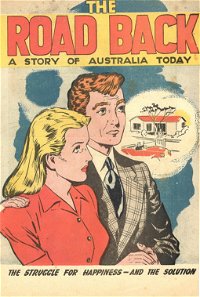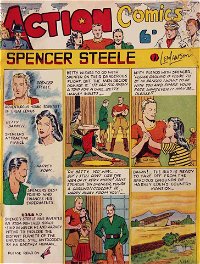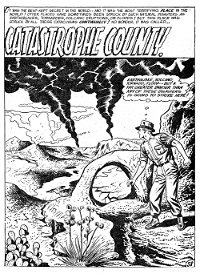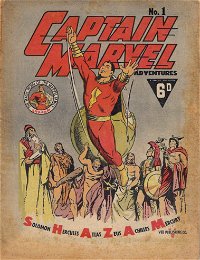Articles
2 November 2022
Vintage Spinner Rack by James Zee

An image sourced from the National Archives of Australia shows a woman in an unidentified Melbourne newsagent. Next to her is a rack with comics on sale.
Based on the available issues, this was probably April 1978.
Here's what's been identified on the racks.
Read more29 October 2022
Hopalong Cassidy (remixed) by James

Through the 1950s, Hopalong Cassidy was all the rage in Australia. Perhaps even more than in the US. And for longer.
From 1948, Larry Cleland and then KG Murray reprinted the Fawcett and DC comic series. When DC stopped producing new Hopalong stories in 1959, Murray's dedicated title also ceased, but Hopalong Cassidy stories continued to appear in other KGM titles.
During this period, many DC western characters found themselves magically transformed into Hopalong Cassidy during their travels from the US to Australia. Read more
12 September 2022
Moira Bertram in Armidale by James Zee

Moira Bertram (1913-1993) was one of the few Australian women working in comics during the peak period of the 1940s and 1950s, writing and drawing with a unique style and creative flair. She worked consistently in partnership with her older sister Kathleen Bertram (1909-1977), who provided the stories' distinctive lettering.
It's not clear when the sisters moved from Sydney to rural NSW. In 1928, Moira was in Tamworth sending art to the Sydney Sun's Sunbeams supplement, but it wasn't published. 'Pehaps your drawings were not quite up to the standard,' Sunbeams said.
Read more11 July 2019
'Irreverent Comments' Revisited by James Zee

15 March 2018
Topix announced by James Zee

A brand-new wholesome comic book hit the stands in early 1954, according to Sydney's Catholic Weekly on 11 February 1954 and Melbourne's Catholic Advocate on 25 February 1954. This is a product of its time, battling against the threat of comic books during the moral panic and censorship of the 1950s.
Topix was, the papers insist, a decent answer to the other rubbish on the bookshelves, with artwork of the highest quality and absorbing interest. "It's purpose is fivefold":
Read more1 October 2017
Who is Terry Powis? by James Zee

Terry Powis is credited with nearly half of the comics published by the NSW Bookstall Company when it established its ground-breaking line of Australian comics. Yet there is virtually no information about him.
John Ryan in Panel by Panel acknowledges Powis and Will Donald as 'real pioneers of Australian comic books', before largely dismissing Powis' work:
Read more16 September 2017
NSW Bookstall by James Zee

For a few years from 1940, the long-running NSW Bookstall Company engaged local artists to establish the first distinctive line of Australian comics, including some creators who would continue to produce comics and cartoons for many decades—especially Noel Cook and Brodie Mack.
It was probably in 1879 that Henry Lloyd (1847-1897) gained the rights to run bookstalls at train and ferry stations in NSW, established the N.S.W. Railway Bookstall Company, and modernised an operation previously focused on ticket sales.
Read more3 September 2017
1949 political propaganda by James Zee

Thanks to a generous contributor, AusReprints has a full scan of The Road Back—political propaganda in comic form. The comic is undated, but released ahead of the 10 December 1949 Australian federal election when Labor lost power to a new Liberal Menzies government. It's clearly original work, but it isn't in the common lists of Australian comics and there are no credits in the issue.
John Ryan in Panel by Panel (p. 141) provides some information, but the way he describes the comics' origins is probably misleading. He reports:
Read more17 June 2017
Listing NSW publishers by James Zee

Censorship laws created a list of comic publishers in NSW between 1955 (when the Government substantially amended the Obscene and Indecent Publications Act) and the start of the 1970s (when the law was again reshaped).
The early 1950s saw restrictions on popular literature, driven by a mix of moral panic, international trends, cultural protectionism and vested corporate interests. At the opening of NSW Parliament in August 1954, the Governor told the legislators that “present legislation relating to the control of obscene and indecent publications is considered…inadequate and a measure to enable publications of this nature to be dealt with more effectively will be submitted to you.”
Read more7 May 2016
Thorpe & Porter by James Zee

To paint a broad picture of Australian comics history, AusReprints includes many comics published in the UK for Australians. One company in particular printed some separate editions with Australian pricing and advertising on the covers: the publishers of Classics Illustrated (distributed by Ayers & James) in 1950s and 1960s, and Tarzan and Korak comics in the 1970s.
The company is generally known as Thorpe & Porter or Top Sellers (common names on the comics), but it includes a cluster of publishers that ultimately became part of Time-Warner, the modern owner of DC Comics.
Read more20 August 2015
Nothing New by James Zee

While there are many local creations on the front of US reprints in Australia, the cover design of Magazine Management’s Triple Western and Triple Adventure stood out to me as unique.
As the name suggests, Triple Western (The Red Circle Press, 1955-1957, 21 issues) and Triple Adventure (Approved Publications, 1957-1958, 5 issues) included (most of the time) three stories.
Read more16 August 2015
Does it exist? Pt 2 by James Zee

Some Australian publishers started series at random numbers, but the first issue of a Magazine Management title was typically #1. Despite that, a few of its series mysteriously lack low numbered issues and probably don’t start at #1.
Two titles stand out: Angel and Daffy.
Read more13 December 2014
Aus via Italy by James Zee

In August I purchased , mainly because I can't resist a mystery. I hadn't come across the series and didn't recognise the featured characters.
It turns out the comic has one Diet Slurp story, with the rest composed of reprints from US Quality's >Feature Comics (Perky) and Modern Comics (Will Bragg) that were a decade old even when this issue was published. But the source of the lead feature remained unidentified.
Read more7 November 2014
Chucklers did that? by James Zee

There’s a surprising wealth of international work in Australian comics, despite the dominance of US reprints—including one series reported as never published in English.
That feature was “The Blue Triangle featuring Dan Cooper”, which appeared two pages per week in The Australian Chucklers’ Weekly from v5#39 (23 January 1959) until about v6#30.
Read more17 September 2014
30,000 Aus comics by James Zee

AusReprints has reached a landmark 30,000 Australian issues, both reprints and original work.
The comic that tipped it over the threshhold was Penny the Favourite Teenager #13 from Young's Merchandising Company. And it's an unexpected comic worth highlighting.
Read more5 April 2014
Twice Approved by James Zee

I've been puzzled by the publisher of the rare Australian series Little Trimmer Comic, but I've not seen a copy until recently.
It's one of those situations where I've wondered if respected Australian comics' historian John Ryan 'got it wrong'.
Read more16 March 2014
Does it exist? Pt 1 by James Zee

There are a few Australian comics that collectors look for that, most likely, were never published.
One well-documented case is The Phantom (Frew, 1948 series) #330 from 1966. The artwork was irretrievably damaged prior to printing and the following issue (#331) was brought forward to fill the gap. However, due to an oversight, the issue numbering was not updated, leaving a gap (although there was no break in publication).
Read more9 March 2014
Possible AusOriginal by James Zee

Despite Mick Stone's disclaimer of "likely omissions", it's rare to find a comic by Australian creators missing from his checklist of Australian comics.
One possible addition to the index is , a mystery one-shot comic without creator credits. The title story, which takes up the entire issue, is not reprinted from a typical US source.
Read more26 February 2014
Dating OPC by James Zee

Most Australian comics from the Second World War are undated one-shots, making it challenging to know exactly when they were published. Sometimes it isn't even possible to be sure of the year of publication.
Comics from the Offset Printing Company (OPC) are a classic example. Most suggestions for dates seem to resort to a generic year in the early to mid 1940s.
Read more11 February 2014
Renovation Time by James Zee

AusReprints turned ten last year and it's time for an overhaul.
I'm receiving increasing reports of site errors. I appreciate it, since I frequently use the database off-line and don't see problems on the site. Most errors can be quickly fixed, but the real problem is that AusReprints has much the same technology as it did a decade ago.
Read more27 April 2013
H. John Edwards by James Zee

While many Australian publishers disguised the international origins of their comics, H. John Edwards reprints were branded with the logos of US companies such as Fiction House, Standard and MLJ Magazines (Archie).
He also published a large line of original Australian comics with art by some of this country's most accomplished artists, including Larry Horak, John Dixon and Jeff Wilkinson.
Read more15 October 2012
Australian DC reprints by James Zee

KG Murray (and later Federal) published DC comics in Australia, didn't they?
Well yes... mostly. I've just struck a DC series published by another Australian company, which reminds me that some DC series ended up in the hands of other Australian publishers.
Read more13 October 2012
Jesús Blasco in Valentine by James Zee

There's a stunning scene of Sydney Harbour in a mid-1960 British comic: 'Don't Ever Leave Me', Valentine Picture Story Library (Fleetway, 1960 series) #4.
Particularly interesting is the empty peninsula where the Opera House is now, with Farm Cove beyond. The former Fort Macquarie Tram Depot was demolished in 1958 and work began on the Opera House March 1959. The crane in the drawing would be working on the project's fist stage.
Read more4 October 2012
Puzzling censorship by James Zee

Here's a puzzle about an unedited "sexy" Australian reprint at a time when the contempory US printing was edited—presumably to comply with the Comics Code Authority.
The story in question is "My Rebellious Heart" from Teenage Love #29 (Barmor Publications), which probably dates from 1954. As with many Australian comics this issue is undated, but some recently auctioned Harvey file copies of earlier issues have dates stamped on the cover.
Read more1 July 2012
KG Murray archives by James Zee

KG Murray's re-use of stories from Five-Score Comic Monthly #10, February 1959 suggests an extraordinary archive must have once existed at the company's headquarters.
The story 'Catastrophe County.' (note the full stop) is a reprint of 'Catastrophe County, U.S.A.' from Strange Adventures #63, December 1955. Such localisation was common at the time: 'Million Pound Ticket', a Mr. District Attorney story in the same issue, was originally 'Million Dollar Ticket'.
Read more30 June 2012
No publisher printed by James Zee

It's rare for an Australian comic to have no publisher listed. An unnumbered, undated issue of Li'l Genius is one of the few I've seen.
The comic probably dates from 1958/1959 or into the early 1960s. Its cover is from Charlton's Li'l Genius #9 (1955)—and probably the contents also, but I can't find information to be sure.
Read more3 October 2011
Disney by James Zee

Between 1946 and 1978, Australian Disney comics were continuously produced by W.G. Publications (renamed Wogan Publications in 1974)—although other companies published some Disney comics for Australia before, during and after that time.
John Sands published a few Disney comics in the 1930s, with a handful more by Ayers & James in the 1940s. The Australian Woman's Weekly also published at least one in the 1940s, with free promotional comics from Nabisco (Wheaties) in the 1950s and Mobil in 1964.
Read more12 July 2011
Ayers & James by James Zee

The Australian run of Classics Illustrated, commencing in 1947, is Ayers & James most enduring and famous comics legacy, although the company is associated with thousands of comics from the 1940s until the 1970s.
Most of this publishing output is disguised behind diverse trading names or successors—such as Red Circle Press, Illustrated Publications, Approved Publications and others—all associated with the later Magazine Management company.
Read more1 May 2011
AusReprints needs your comics by James Zee

This website is a collaborative effort! Since AusReprints.com went online in 2003, I've made surprising progress documenting Australian reprint comics. But I need your help with issues I don't have.
The easiest way to help is to email me a high quality scan of missing or poor quality covers. If you have the time, I also welcome story details and full content information. All contributions can be emailed to me at the link at the bottom of this page.
Read more8 April 2011
Atlas by James Zee

Capitalising on the success of KG Murray's Superman reprints, Atlas Publications entered the comics field in January 1948 with Captain Atom, a full colour comic by Australians Arthur Mather and Jack Bellew (as John Welles). Wartime bans on imported periodicals were still in place at the time, creating strong demand for new local periodicals.
While early Atlas comics mimicked the look of Murray's contemporary comics, the company quickly created a strong identity by being one of the few Australian comics' publishers to consistently brand its publications on the cover. Until 1951, most of its comics were also printed in a distinctive landscape format that was better suited to its dominant newspaper reprints.
Read more11 October 2010
Larry Cleland by James Zee

In 1946, during the post-war boom in Australian comics, the Vee Publishing Co. entered the market with an extensive programme of US Fawcett reprints. This company became Larry Cleland Pty. Ltd around 1949/50, although Stanley Larry Cleland had been associated with the company since its foundation.
Cleland has no publishing record prior to Vee Publishing, and it is unknown how he secured the rights to Fawcett's material. However, the company quickly expanded its range of black and white reprint editions to include a dozen or more humour, super hero and western comics.
Read more26 August 2010
Frew by James Zee

While The Phantom is Frew Publications' most famous and only remaining comic, from the late 1940s the company also published a wide range of other reprints and original Australian comics.
In 1948, Ron Forsyth, Jim Richardson, Jack Eisen and Peter Watson put in £500 each to found Frew, using an acronym of their four surnames to name the new company—although Eisen and Watson withdrew before the first comic was produced. For the next 40 years, Forsyth and Richardson shaped the company into an Australian icon.
Read more5 August 2010
Newton by James Zee

Newton Comics was a short-lived range of Marvel reprints produced in 1975 and 1976 as part of an excentric publishing empire based around Maxwell Newton's six year run on the trashy tabloid, the Melbourne Sunday Observer.
When publisher Gordon Barton abandoned his Observer in 1971, Newton quickly put out a replacement through Regal Press. The comics were part of a range of magazines and external jobs that kept the presses running throughout the week, not just the two days needed for the Sunday Observer. Other projects included teen mags such as Scream and Sweet, entertainment publications National Tattler and TV Guide, and the pornographic Pleazure, Eros and Kings Cross Whisper.
Read more4 July 2010
International sources by James Zee

Until the 1980s, Australian access to international comics was limited due to a range of factors, including distribution monopolies, exclusive licences, geograpical isolation, cultural bias toward British publications and war-time import restrictions.
During and following the second world war, a thriving local comics industry developed, including the publication of thousands of reprint comics. At the start of the 20th century, British material had dominated the Australian market. The earliest comics were modeled on British weekly newspaper-style comics, until the US format and US sources began to dominate in the 1940s.
Read more29 June 2010
Murray by James Zee

From 1946 until 1983, the K.G. Murray Publishing Company produced comics under a range of imprints—Climax Comics, Blue Star, Colour Comics, Planet Comics and finally Murray Comics.
While most of these were DC reprints, some included original Australian work and reprints from such diverse publishers as ACG, Charlton, Avalon, Novelty Press, Quality, Comic Media, Ziff-Davis, St. John, Ajax-Farrell, Fiction House and Atlas/Marvel. From the late 1960s, some series included translated comics, particularly from Spain's Selecciones Ilustradas agency.
Read more29 June 2010
Various by James Zee

Australian access to international comics was limited until the 1980s, resulting in a strong local comic industry, including reprint comics.
Many of the earliest and most popular Australian comics were based on reprints of newspaper strips, reflecting international trends and later providing an opportunity to circumvent import restrictions. The mid-1930s saw significant expansion of syndicated newspaper material in Australia, particularly following formation of the Yaffa Syndicate to distribute material from King Features Syndicate.
Read more17 June 2010
Federal by James Zee

Between 1983 and 1986, the Federal Publishing Company (FPC) reprinted contemporary DC and Marvel comics, occasionally dipping into a backlist of stories acquired from the K. G. Murray Publishing Company.
FPC was a new publishing division of Hannanprint, formed through the acquisition of leisure and special interest publications from ACP Publishing, the company that acquired Murray from its founding family in 1972. Hannanprint's Eastern Suburbs Newspapers (subsequently ESN The Litho Centre) also became the printers for the comics at that time.
Read more16 June 2010
Page/Yaffa by James Zee

Throughout the 1960s and 1970s, the Yaffa Publishing Group produced a range of mainly reprint comics under "Yaffa" and "Page" imprints or company divisions.
David Yaffa founded his company around 1925 with the publication of Newspaper News (later AdNews), an advertising and marketing magazine. The Yaffa Syndicate's earliest comics involvement was the distribution of newspaper strips from King Features Syndicate (such as Flash Gordon, Brick Bradford and Mandrake the Magician). Page Publications, the imprint of most of Yaffa's comics, was established as a separate entity in the 1960s.
Read more15 June 2010
Horwitz by James Zee

From about 1950 to 1966, Horwitz Publications was a large publisher of war, western and crime comics, including popular titles such as Navy Combat, Fast Gun, Wyatt Earp and Buffalo Bill.
Horwitz predominantly reprinted US comics, sourced mainly from Timely/Atlas/Marvel, but with other US publishers and newspaper strip reprints. In the late 1950s, it created some local comics, notably adaptations of its Carter Brown novels and The Phantom Commando, created by John Dixon but passed to Maurice Bramley (b 1910) who drew it until 1956.
Read more14 June 2010
Gredown by James Zee

From around 1975 to 1984, Gredown published a diverse range of magazine-size comics, predominanly horror but also western, science fiction and other genres. Beginning as sequentially-numbered magazine-size series, the comics later became mainly one-shots with a wildly eccentric range of titles.
Little is know about Gredown's origins, although it seems the company was formed to compete with KG Murray. Greg Murray appears to have established Gredown after his father, Kenneth G. Murray was bought out by Australian Consolidated Press (APC) in 1974. The earliest Gredown publications were magazines, but the company's output was soon focused on reprint comics.
Read more16 April 2010
The Vroom by James Zee

One of the last Spanish series to debut in KG Murray's line of reprint comics was The Vroom, a particularly obscure series due to its inconsistent Australian publication and limited international printings.
Read more
5 April 2010
Literacy, Deliquency and Captain Triumph by James Zee

Just after Christmas 1948, during the holiday silly season when newspapers desperately seek copy to fill their pages, the Sydney Morning Herald opened up debate about the impact of comics on young people.
The final pages of this article reproduce in full the sensationalist and shallow article that may have helped crystalised popular discontent over comics corrupting Australian youth. It represents a fascinating early skirmish in the cultural tensions that erupted into overt censorship during the 1950s, particularly focused around Fredric Wertham's Seduction of the Innocent, published in 1954.
Read more28 August 2009
A Man Called... Sunday by James Zee

Alongside the comic's lead character, KG Murray's Ringo 24 gave cover-billing to a new series: "Introducing-- A man of courage who rides alone. A man called... Sunday".
From 1973 to 1977, Sunday appeared every issue and usually received cover promotion. The final Sunday episode is in Ringo 41, the comic's second last issue. Remarkably for KG Murray, all 18 episodes were printed in order and on a regular schedule.
Read more10 August 2009
Johnny Galaxy and the Space Patrol by James Zee

Johnny Galaxy and the Space Patrol was among the earliest work from Spanish agency Selecciones Ilustradas (SI) to be printed by KG Murray.
The feature was first published in Australia in its own title (1967-1968) composed almost entirely of Johnny Galaxy stories. When that series ended with four issues, the feature moved to Climax Adventure Comic (1968–1973) and finally Super Giant (1973), anthologies that hosted work from a wide array of sources.
Read more1 August 2009
Ringo, Big River Lawman by James Zee

With a feast of four Ringo stories filling the issue cover-to-cover, Murray launched its long-running, 42-issue series .
The first handful of Ringo issues continued the feature-length approach, which was uncommon for KG Murray at the time. Most of its comics were anthologies and the Ringo series soon reverted to a single feature story as well, backed up by reprints of other western stories from diverse sources.
Read more1 August 2009
Geminis by James Zee

The Australian run of Geminis began mid-1975 in Climax Adventure Comic, before transferring to Super Giant Album for the concluding episodes.
Composed of eight episodes of 20 pages each, Geminis is an espionage story set during the first world war, from July 1914.
Read more1 November 2008
Moira Bertram: Queen of the Comics by Kevin Patrick

Back in late 2003, a copy of an old Australian comic dating from the mid-1940s sold for nearly AU$350 on eBay Australia.
There's nothing unusual about this in itself – the last five years or so have seen dozens of vintage Australian comics being auctioned online for similar amounts.
Read more20 December 2007
Hart Amos—A 1977 profile by John Ryan

Despite his long association with the K.G. Murray Publishing Company, very little is known about the late Hart Amos (2/12/1916 – 8/6/2000), a talented and prolific artist who produced countless covers for Murray's range of American reprint comics.
However, as the following 1977 profile written by Australian comics' historian John Ryan demonstrates, this was just one aspect of Amos' lengthy and diverse career.
Read more1 July 2007
Don Richardson—Comic Book Maker by Kevin Patrick

If the name Don Richardson sounds unfamiliar to you, don't worry—you won't find his name appearing on any of the comic books in your collection.
I'd never heard of Don either, until I received an email from him, quite out of the blue, on 11 January 2004.
Read more24 April 2006
Peter Fatches—The Mistaken Ambulance Mystery by Kevin Patrick

One of the pleasures of flicking through old Australian comics is that you never know what you'll find.
This was certainly the case when I picked up a secondhand copy of Super Giant Album 23, which was originally published by the KG Murray Publishing Company (Sydney).
Read more